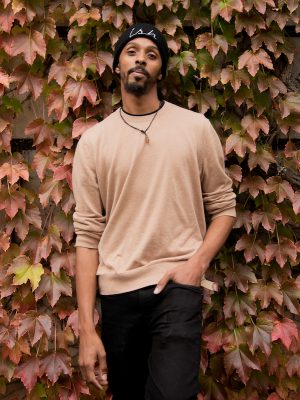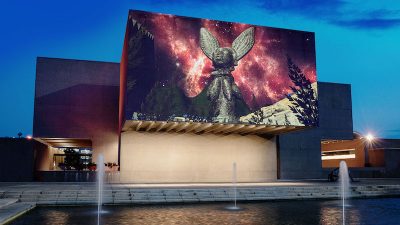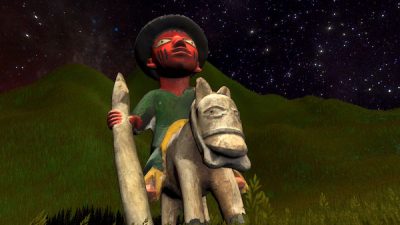In Syracuse University School of Education doctoral candidate Evan Starling-Davis’ innovative new exhibition, viewers can interact1 with an Urban Video Project2 projection on the façade of Syracuse’s Everson Museum, using their personal smart devices to explore3 the virtual world of FRACTURE.
FRACTURE by Evan Starling-Davis4
Urban Video Project (Syracuse University Light Work)
Through Sept. 23, 2023
Thursdays – Saturdays | Dusk – 11 p.m.5
Everson Museum Plaza
401 Harrison St., Syracuse, NY 13202
Artist’s Talk
Syracuse University Human Rights Film Festival
Saturday, Sept. 23, 2023 | 4 p.m.
Shemin Auditorium, Shaffer Art Building
Starling-Davis describes FRACTURE as an Afro-Surreal poetic experience6 featuring 3D renderings of objects from Afro-diasporic culture7 in local collections and archives, including the Syracuse University Art Museum. Through this experience, FRACTURE transforms the Everson Plaza into a space of communal interactivity8—between viewers, the virtual world, and each other.
Leaning into the experience of play9, FRACTURE allows the audience to immerse themselves imaginatively in a created world, taking time to reflect on the possibility suggested by the phrase, “Maybe you may find yourself in the FRACTURE.”10
NOTES
 1 Viewers are invited to interact with FRACTURE’s virtual reality experience by first scanning a QR code that is projected on the Everson Plaza wall. The code then turns a smartphone into a game controller, allowing the viewer to manipulate the projection and become part of the experience. “I like to think out of the box,” says Starling-Davis. “How can we push the public space and transform it into a virtual/physical hybrid space? In doing so, what then do we define as reality?”
1 Viewers are invited to interact with FRACTURE’s virtual reality experience by first scanning a QR code that is projected on the Everson Plaza wall. The code then turns a smartphone into a game controller, allowing the viewer to manipulate the projection and become part of the experience. “I like to think out of the box,” says Starling-Davis. “How can we push the public space and transform it into a virtual/physical hybrid space? In doing so, what then do we define as reality?”
2 Starling-Davis first had the idea for FRACTURE before the coronavirus pandemic began in late 2019. Eventually, with support from Anneka Herre, Program Director of the Urban Video Project (UVP), and grants from the Syracuse University Humanities Center, New York State Council on the Arts, and CNY Arts—what Starling-Davis calls a “city and University ecosystem of support”—he was able to develop the idea more fully. Across seven months, he worked with software developers Sonny Cirasuolo and Gary Tyler McLeod and 3D model and game engine consultant Chanee Choi to realize his vision. “They were a beautiful team, good pillars to move the project from conceptualization.”
3 FRACTURE is a multimedia exhibition that includes Starling-Davis’ collages and poetry. “Using poetic inquiry and mindful meditations, I have created a space for people to sit in silence, breathe—and play.”
4 Evan Starling-Davis is a Syracuse-based narrative artist, curator, and digital-age griot using a Black/Queer surrealist lens to unearth distant pasts and buried histories while promoting radical self-healing. As a community organizer and scholar-practitioner with a deep-rooted social practice of art exposure, equitable literacies, accessibility, and community mindfulness, Starling-Davis strives to create pathways for Black imagination and history to thrive.
 5 Starling-Davis is offering pop-up conversations for anyone interested in interacting with the exhibit: contact eadavi02@syr.edu. Starling-Davis’s artist talk will be at the Shemin Auditorium, Shafer Art Building starting at 2:15 p.m. on September 19.
5 Starling-Davis is offering pop-up conversations for anyone interested in interacting with the exhibit: contact eadavi02@syr.edu. Starling-Davis’s artist talk will be at the Shemin Auditorium, Shafer Art Building starting at 2:15 p.m. on September 19.
6 “Afro-Surrealism is part of the Black Speculative Arts Movement. It’s surrealism, but through an Afro-diaspora lens, making the case that Black voices were left out of the Surrealism movement,” explains Starling-Davis. “Artist D. Scot Miller coined the name of the movement, which is also a way of looking at social issues through a surrealist lens, encompassing Black and Brown experience.”
7 This iteration of Starling-Davis’ project uses just a small portion of the more than 100 Yoruban (West African) artifacts in the stewardship of SU Art Museum’s archived collection, originally collected by Professor Andre Nitecki, a librarian and art historian. Objects were scanned on a smartphone using the Polycam app (“3D capture for everyone,” the app’s marketing copy announces). Once Starling-Davis has carefully scanned an object from all angles, the app renders a photogrammetry version of the object that can then be manipulated in video and virtual reality.
8 “I spent a lot of intimate time with the objects, documenting them, asking myself how they are spiritually affecting me, being inspired by them, and thinking creatively about how to bring the archives to the people to create more public-facing engagement,” explains Starling-Davis, whose work encompasses photography, playwriting, literacy (via Writing Our Lives), social justice (Lender Center), art curation (Community Folk Art Center), and museum studies (his master’s in that subject is from Syracuse University).
9 “FRACTURE uses the mechanics of gaming and game play and how it speaks to our imagination, play, and mindfulness.” Starling-Davis adds that the project will form the spine of his Ph.D. dissertation, and he intends to follow it with literacy programming that he will take into local communities, schools, after-school programs, and elsewhere.
10 The name of the exhibition derives from African American rhetorical traditions, which Starling-Davis encountered through Professor Kevin Browne’s teaching and Christina Sharpe’s scholarship (she is the author of In the Wake: On Blackness and Being). “The idea of ‘wake work’ and fractured identity looks at identity against the extremes of a black and white world. When we engage with art, we can find our identity by playing with things we don’t normally play with. My piece fractures identity and fractures the public space, between the physical and virtual. It is complex and layered—how far can we fracture in order to know, think, and feel in new ways.”
